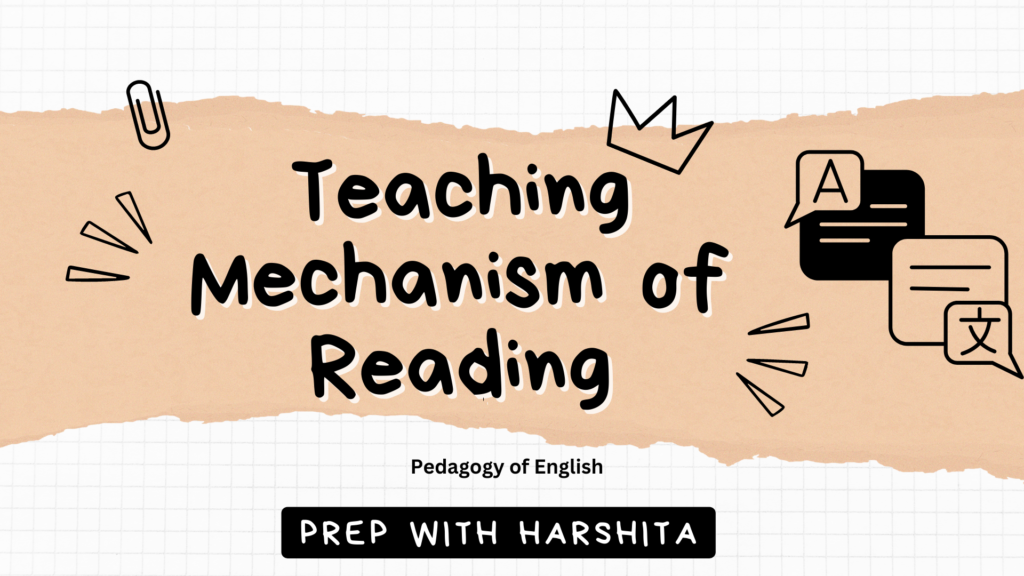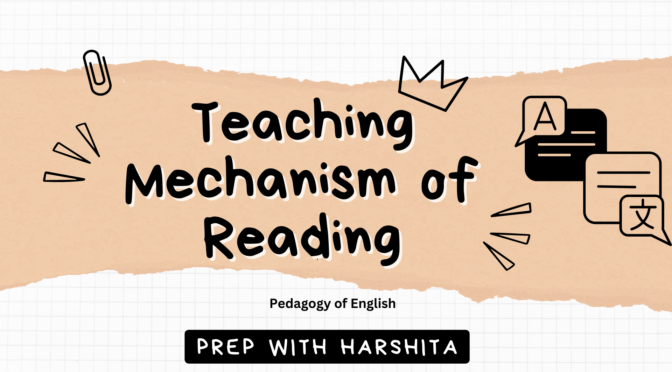Teaching reading is a complex process that involves various mechanisms and strategies to support students in developing their reading skills.
Here is a detailed explanation of some key mechanisms for teaching reading:
- Phonics Instruction: Phonics instruction focuses on the relationship between letters and sounds. It helps students learn how to decode words by recognizing and blending individual letter sounds. Phonics instruction typically includes:
- Letter-Sound Correspondence: Teaching students the sounds associated with each letter or letter combination, known as phonemes. For example, understanding that “c” makes the /k/ sound in words like “cat.”
- Phonemic Awareness: Developing students’ ability to hear, identify, and manipulate individual phonemes in spoken words. This includes activities such as segmenting sounds in words or blending sounds to form words.
- Phonological Awareness: Building awareness of larger units of sound, such as syllables, rhymes, and onset-rime patterns. Activities may include identifying words with the same beginning sound or recognizing rhyming words.
- Vocabulary Development: Building vocabulary is crucial for reading comprehension. Teachers can use various strategies to support vocabulary development, including:
- Explicit Instruction: Teaching new words directly, providing definitions, and discussing their meanings.
- Context Clues: Helping students use the context of the text to infer the meaning of unfamiliar words. This involves examining the surrounding words, sentences, or paragraphs to gather clues about the word’s meaning.
- Word Families and Word Analysis: Teaching students about word families (e.g., words with the same root) or word parts (e.g., prefixes, suffixes) to help them recognize and understand new words.
- Wide Reading: Encouraging students to read extensively across different genres and topics to expose them to a wide range of vocabulary.
- Comprehension Strategies: Teaching comprehension strategies equips students with tools to understand, analyze, and interpret texts. Some common comprehension strategies include:
- Activating Prior Knowledge: Helping students make connections between their existing knowledge and the text they are reading.
- Predicting: Encouraging students to make predictions about what will happen in the text based on their understanding of the topic or genre.
- Questioning: Teaching students to ask questions while reading to promote active engagement and deeper understanding of the text.
- Visualizing: Guiding students to create mental images or “mind movies” while reading to enhance comprehension and create a vivid understanding of the text.
- Making Connections: Encouraging students to relate the text to their own experiences, other texts, or the world around them.
- Summarizing: Teaching students to identify and synthesize the main ideas and key details of a text to create a concise summary.
- Monitoring Comprehension: Helping students develop strategies to monitor their understanding while reading and use appropriate strategies to clarify confusion or gaps in comprehension.
- Guided Reading: Guided reading involves working with small groups of students who are at similar reading levels. The teacher selects texts appropriate for each group and provides targeted instruction and support. This mechanism typically includes:
- Text Selection: Choosing books that align with students’ reading abilities and provide appropriate challenges to support their growth.
- Pre-Reading: Previewing the text, discussing the title, making predictions, and activating prior knowledge to prepare students for reading.
- Guided Reading: Students read the text independently or take turns reading aloud, while the teacher provides support, guidance, and instruction tailored to their needs. The teacher may ask questions, model reading strategies, and facilitate discussions.
- Post-Reading: Engaging students in discussions, reflections, or activities that deepen their comprehension and extend their thinking about the text.
Guided reading allows for individualized attention, targeted instruction, and gradual release of responsibility as students become more independent readers.
- Independent Reading: Independent reading provides students with opportunities to practice reading skills and develop reading fluency and stamina. Some elements of independent reading include:
- Choice of Books: Allowing students to select books that interest them and are at an appropriate reading level.
- Sustained Silent Reading: Allocating dedicated time during the school day for students to read independently.
- Reading Logs: Encouraging students to keep a record of the books they read, their thoughts, or reflections about the text.
- Book Talks or Recommendations: Providing opportunities for students to share their reading experiences, recommend books to their peers, or engage in discussions about books they have read.
Independent reading helps students develop a love for reading, explore different genres, and become more confident and fluent readers.
- Close Reading: Close reading involves a deep analysis of a text to develop a thorough understanding. This mechanism typically includes:
- Multiple Readings: Engaging students in reading the text multiple times to notice details, make connections, and analyze the author’s choices.
- Text-Dependent Questions: Asking questions that require students to refer explicitly to the text and support their answers with evidence.
- Annotation: Encouraging students to annotate the text by underlining important information, highlighting key ideas, or making marginal notes.
- Analyzing Language Choices: Guiding students to examine the author’s use of language, literary devices, and rhetorical strategies to understand how they contribute to the meaning of the text.
Close reading helps students develop critical thinking skills, promotes textual analysis, and enhances comprehension.
- Scaffolding and Differentiation: Scaffolding involves providing temporary support and guidance to help students tackle more challenging texts. Differentiation ensures that instruction and reading materials are tailored to individual students’ needs. Some strategies for scaffolding and differentiation include:
- Pre-Teaching Vocabulary: Introducing and explaining key vocabulary words before students read the text.
- Previewing: Offering an overview of the text, discussing its structure, and setting purposes for reading.
- Graphic Organizers: Providing visual tools such as graphic organizers, charts, or diagrams to help students organize their thinking and make connections.
- Modeling: Demonstrating reading strategies, thinking aloud, and showing how proficient readers approach a text.
- Flexible Grouping: Grouping students based on their reading abilities and providing targeted instruction or support accordingly.
- Differentiated Reading Materials: Offering texts at varying reading levels or providing additional support materials for struggling readers.
Scaffolding and differentiation ensure that all students can access and engage with texts at their appropriate instructional level, promoting growth and success.
- Authentic Reading Experiences: Engaging students in authentic reading experiences helps them make connections to real-life contexts and develop a broader understanding of the world. Some ways to incorporate authentic reading experiences include:
- Reading Newspapers or Magazines: Providing opportunities for students to read and discuss current events or articles.
- Literature Circles or Book Clubs: Facilitating small-group discussions about specific books or genres, allowing students to share their thoughts, interpretations, and recommendations.
- Integration of Reading Across Subjects: Integrating reading activities and texts into other subjects, such as science, social studies, or math, to reinforce content learning and promote cross-curricular connections.
- Reading for a Purpose: Assigning reading tasks that have real-world applications, such as researching a topic, following instructions, or reading for specific information.
Authentic reading experiences help students see the relevance and importance of reading in their lives beyond the classroom.
- Assessment and Feedback: Assessing students’ reading skills and providing timely feedback are crucial for monitoring progress and guiding instruction. Some assessment and feedback mechanisms include:
- Running Records: Administering individual assessments to evaluate students’ reading fluency, accuracy, and comprehension.
- Comprehension Questions: Asking questions or providing prompts to assess students’ understanding of the text.
- Reading Logs or Journals: Reviewing students’ written reflections, summaries, or responses to gauge their engagement and comprehension.
- Performance Tasks: Assigning tasks or projects that require students to apply their reading skills, such as creating book reviews, giving presentations, or participating in reader’s theater.
- Individual Conferences: Engaging in one-on-one conferences with students to discuss their reading progress, set goals, and provide personalized feedback.
Assessment and feedback mechanisms help teachers track students’ growth, identify areas for improvement, and guide instructional decisions.
- Collaboration and Discussion: Encouraging collaboration and discussion around reading fosters peer interaction, expands perspectives, and deepens understanding. Some collaborative mechanisms include:
- Partner Reading: Pairing students to read aloud to each other, discuss texts, or support each other in comprehension.
- Literature Circles or Book Clubs: Forming small groups of students who read the same book and meet to discuss it, share insights, and engage in critical conversations.
- Shared Reading: Reading a text as a whole class and engaging in discussions, predictions, or analysis together.
- Online Discussions: Using digital platforms or discussion boards to facilitate asynchronous or synchronous discussions about texts.
Collaboration and discussion promote active engagement with the text, provide opportunities for diverse perspectives, and enhance comprehension through shared insights and reflections.
By incorporating these mechanisms into their reading instruction, teachers can create a comprehensive and supportive learning environment that helps students develop their reading skills, comprehension, and a lifelong love for reading.
Also Read : Function of Language in Classroom Learning

Also Visit : Prep with Harshita


19 thoughts on “Teaching Mechanism of Reading”